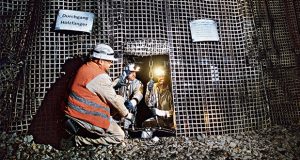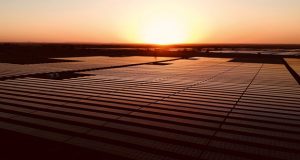In contrast to the general trend, manufacturers of mining machinery in Germany are expecting 2019 to have been one of the best years on record. The German Engineering Federation (VDMA), Frankfurt am Main/Germany, is anticipating an increase in turnover of 38 % that would amount to around 5 bn €. This revenue should at the very least be maintained in 2020.
In Germany mining machinery manufacturers are expected to increase their turnover by 10 % to 110 M €. As Michael Schulte Strathaus (Figure 1), the chair of the VDMA’s mining division, remarked during the annual press conference at the Zollverein mine in Essen, the decision to phase out power generation from lignite and the declining opportunities to continue the promotion of domestic raw materials has resulted in the domestic market becoming “something of a marginal phenomenon”. He pointed out the increasing difficulty of land-use planning as well as the excess planning of deposits further contributed to the issue. For the year 2020, the VDMA is therefore assuming only slight changes in revenue at most.
In the case of business conducted internationally, however, the outlook is far more satisfying. An increase in revenue of 38 % in 2019 has resulted in a total calculation of approximately 4.9 bn €. Consequently, the export rate amounts to 98 %. For 2020, the sector anticipates that it will at the very least be able to maintain its revenue. According to Schulte Strathaus, detrimental factors have included the trade dispute between the USA and China, a repeated postponement of Brexit and ongoing tensions in the Middle East. In the medium and long term, however, the sector expects that demand will continue to increase. In this regard, the chair referred to calculations from the OECD, according to which the world population will have increased to over 9 bn people by 2050 and demand for resources will have doubled by 2060.
In order to meet the demands of the digital age, mining machinery manufacturers are increasingly counting on machines and systems that can be deployed in the hard-rock mining sector. In the words of Schulte Strathaus: “It is precisely within this area that a number of metals are being obtained for the digital future. Without them – and consequently, without our products too – digitalisation would simply not be possible.” He emphasised that, while data and energy may form the foundation for the future, there would be no energy in the first place without raw materials.
Issues of sustainability and safety are also at the very top of the agenda for companies supplying the mining sector. Particularly when it comes to safety, German companies are “global leaders”, as Schulte Strathaus puts it. He remarked that there was hardly any foreign manufacturer “that can hold a candle to us in this regard”, and that not least for this reason are mining machines that bear the “Made in Germany” quality seal in high demand worldwide.
The chair noted that there was a growing desire within the sector for politicians responsible for this area to make more of an effort to engage with the African continent. Only this way, he claimed, would the sector be able to pit itself against China. Schulte Strathaus also lamented the fact that an increasing number of investors were pulling their funding out of coal projects. He felt that it was not only his sector that was suffering as a result, but also the European machine engineering industry as a whole.
The chair described the skills shortage in his sector as “dramatic”. He believes that skilled tradespeople need to feel that they are integral to society, rather than being ostracised – as he claims is increasingly the case today. He remarked that getting every single student to sit the Abitur, the standard German school leaving qualification to prepare students for university, would not “help us any further”.
In 2019, the largest sales market was the EU. According to a preliminary estimate, the 28 member states accounted for 25 % of exports. This figure amounted to just over 27 % in 2018. France and the UK were the driving forces behind this. For 2020, a further slight increase in exports to EU countries is expected at the very least.
The second largest export country, with an anticipated proportion of 12 % of all exports, is the USA. In 2018, this figure still amounted to 15 %. According to Schulte Strathaus, a shift in the local energy policies is responsible for this. He remarks that the significance of coal as an energy source goes back a long way. However, since the country is making considerable efforts to bolster the mining sector overall, he reckons that there is “cautious optimism” that exports to the USA will at least be able to be maintained in 2020.
The third largest export country is China. The sector has calculated that just over 10 % of exports went to the People’s Republic of China in 2019. In 2018, this figure was just under 10 %. Admittedly, China’s imports of mining technology have been on a downward trend since 2012. Yet this has only had a limited impact on mining technology made in Germany, asserts Schulte Strathaus. However, he categorised the sales development in the medium term as “rather uncertain”, and many suppliers feel increasingly confronted with rather opaque approval procedures for certain machines and systems.
Chinese mining machinery manufacturers have increasingly avoided their domestic market, which is saturated in many areas, and instead intensified competition on international markets. This is apparently not uncommon with state-subsidised dumping prices, which German manufacturers can only counter through the quality of their products and services. For 2020, it is assumed that the export level will at least be able to be maintained.
Other large sales regions include Russia, Australia, the Middle East and Latin America. (VDMA/Si.)



